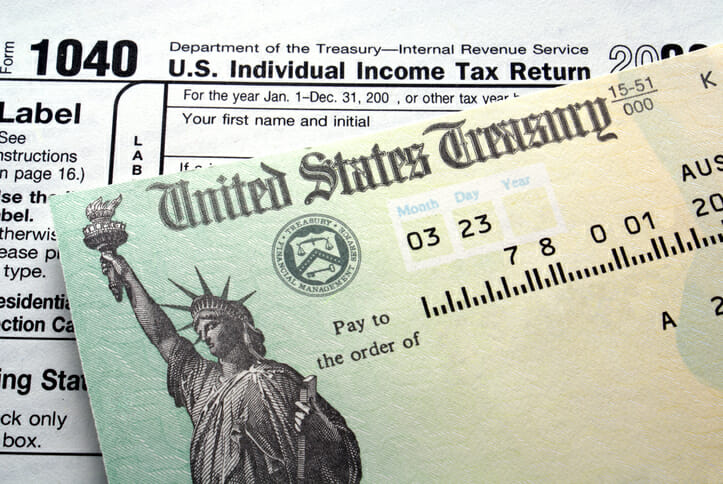The IRS says that the average tax refund for returns filed in 2022 is $3,039. This is an increase of 7.5% when compared with 2021, which averaged $2,827. But for taxpayers expecting to get the same sizable refund next year, Jackson Hewitt urges them to do a midyear tax checkup to prepare for upcoming changes. Let’s take a look at what a midyear tax checkup can do for you and four reasons why your tax refund in 2023 could be smaller.
If you want to optimize your tax strategy, a financial advisor could help you lower your tax liability.
Why You Should Do a Midyear Tax Checkup
The tax preparation company Jackson Hewitt wants you to do a midyear tax checkup to prepare for upcoming tax changes that could make your refund smaller in 2023.
“While most people don’t think about their taxes until the end of the year, July is the perfect time to make a midyear tax-planning appointment, especially this year, when many taxpayers are at risk of experiencing refund shock,” said Jackson Hewitt’s chief tax information officer Mark Steber in a press release.
Jackson Hewitt explains that a midyear tax checkup could help taxpayers with family and employment changes make necessary adjustments now to meet their tax refund expectations.
“If taxpayers are seeing they might have a smaller refund than they expect or even a balance due, there is still time to take action. That could mean anything from increasing tax withholdings for the balance of the year, to increasing contributions to qualified retirement plans, to many other strategies,” Steber said.
Changes in the number of dependents, employment or self-employment income and divorce, among other factors, will affect your tax-filing status and refund for 2023. And, additionally, Jackson Hewitt says you should also prepare for changes that will impact your tax credits, deductions and payments.
4 Tax Changes That Could Make Your Refund Smaller

Jackson Hewitt calls taxpayer attention specifically to four changes that in some cases could mean getting hundreds of dollars less in payments, credits and deductions for your 2023 tax refund.
No additional stimulus payments. Tax refunds were boosted during COVID with three rounds of stimulus checks, also known as economic impact payments or recovery rebate credits. For the third stimulus check, eligible taxpayers were able to get up to $1,400 for individuals ($2,800 for couples). Overall, the federal government made direct payments to individuals adding up to $931 billion. But unlike 2020 and 2021, legislators have not proposed any new stimulus checks for 2022. So taxpayers should not expect to get an additional payment in their 2023 tax refund.
Pre-COVID tax credits. Several tax credits, including the Child Tax Credit (CTC), the Earned Income Tax Credit (EITC) and the Dependent Care Credit will revert back to pre-COVID levels. This means that taxpayers will face substantial cuts when compared with the previous tax year. For a comparison, those who got $3,600 per dependent in 2021 for the CTC will get $2,000 for the 2022 tax year. Similarly, eligible taxpayers with no children who received roughly $1,500 in 2021 will now get $500 in 2022. And the Dependent Care Credit will go back down to a maximum of $2,100 in 2022 from $8,000 in 2021.
Taxpayers should also note that age and income limits will revert to pre-COVID requirements, which means that less people will be eligible.
No above-the-line charitable deductions. During COVID, taxpayers were able to take up to a $600 charitable donation tax deduction on their tax returns. However, in 2022, this deduction will revert back to pre-COVID rules, which will not allow those who take a standard deduction to make an above-the-line deduction for charitable donations.
Tax reporting for third party payments above $600. If you use third party payment apps like Apple Pay, PayPal, Venmo and Zelle, the IRS will require in 2022 that income over $600 annually get reported on all tax returns. And this means that taxpayers may have to pay taxes on that income.
Bottom Line

You can avoid a refund shock in 2023 by doing a midyear tax checkup now. This will allow you to increase tax withholdings, raise retirement plan contributions and make other necessary adjustments to lower potential tax bills and get closer to your tax refund expectations.
Tax Planning Tips
- A financial advisor could help you optimize your tax strategy to lower your tax bill. SmartAsset’s free tool matches you with up to three financial advisors who serve your area, and you can interview your advisor matches at no cost to decide which one is right for you. If you’re ready to find an advisor who can help you achieve your financial goals, get started now.
- If you’re looking for specific midyear moves to cut your tax bill, a financial advisor recommends these four actions.
- And, if you just received your 2022 refund, here are five smart investments to make your refund money work for you.
Photo credit: ©iStock/blackCAT, ©iStock/Inside Creative House, ©iStock/cabania
